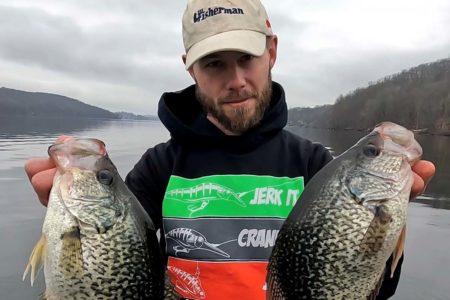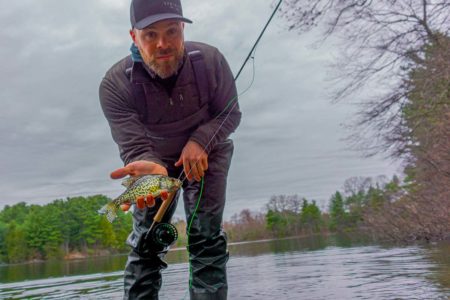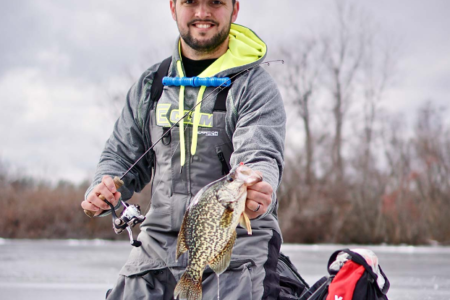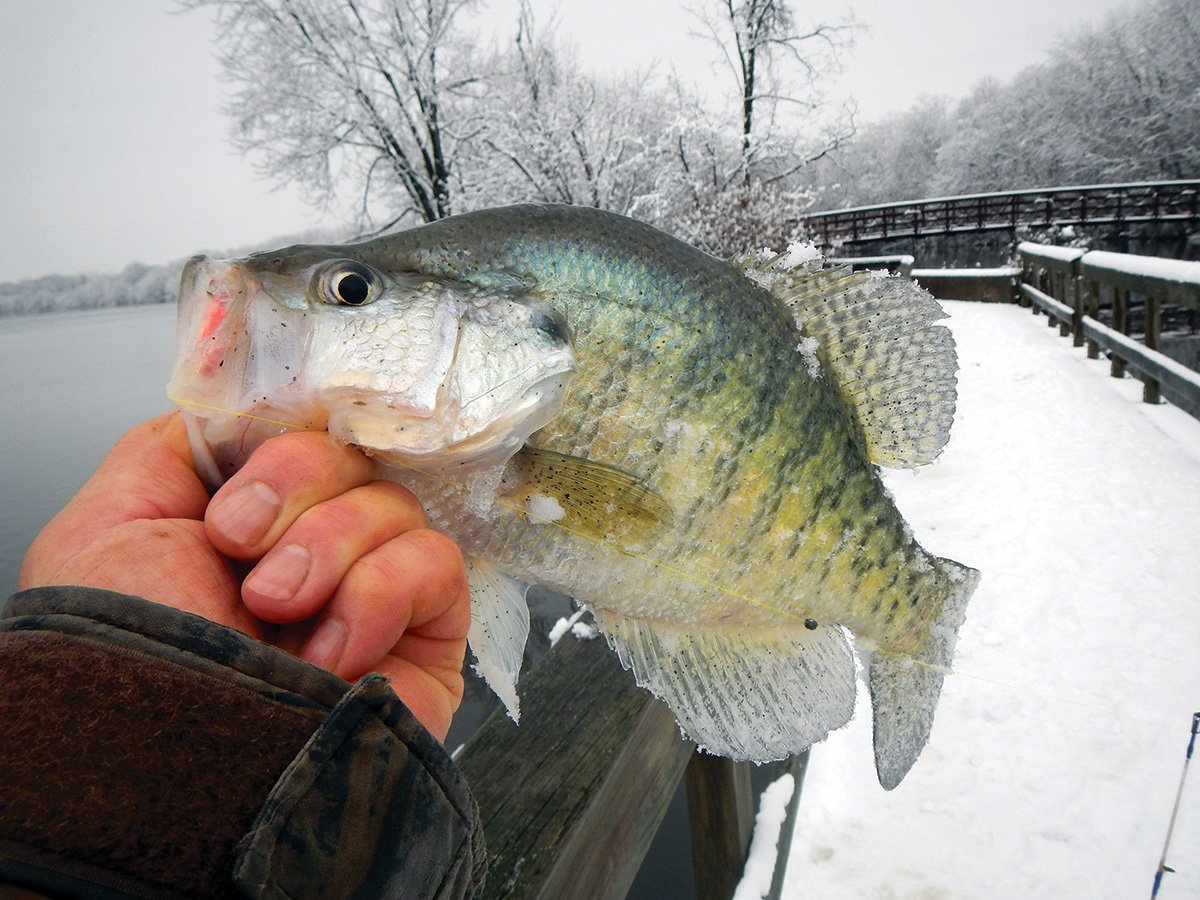
When looking for a bend in the rod this month, don’t look past this feisty freshwater fighter.
Winter fishing along the east coast can be a real crap shoot. What we have for weather all depends on Mother Nature’s mood on any given day, in any given year. For the angler that fishes the year round, this makes what you catch on any given year pot luck.
One species of freshwater fish that is active the year round is the crappie. Makes no difference if we have a mild winter or a hard one, Mr. Calico can be found ready to take your offerings, and all you have to do is know where to look and what will take him.
Bridge Basics
One place that usually holds crappies the year round are waters under and around a bridge. These waters are some of the last to freeze and even when there is ice on most lakes, a bridge often offers open water to fish which can be productive for crappies. First off, deep water is usually found around or close by; often times they are the only structure in a particular section of a lake.
One of the main reasons for crappie productivity around a bridge is that they’re usually located where streams flow into a lake or headwaters, and are areas where crappies will move into in the late season. Plankton and aquatic insect life abound in these areas, which are usually carried by a stream’s current into a lake. This prime forage often settles into the deeper waters around a piling, or gets trapped in an eddy that is created behind and close to the piling. Thus this gives crappies two of the basic ingredients of a cold water holding spot, comfort and forage.
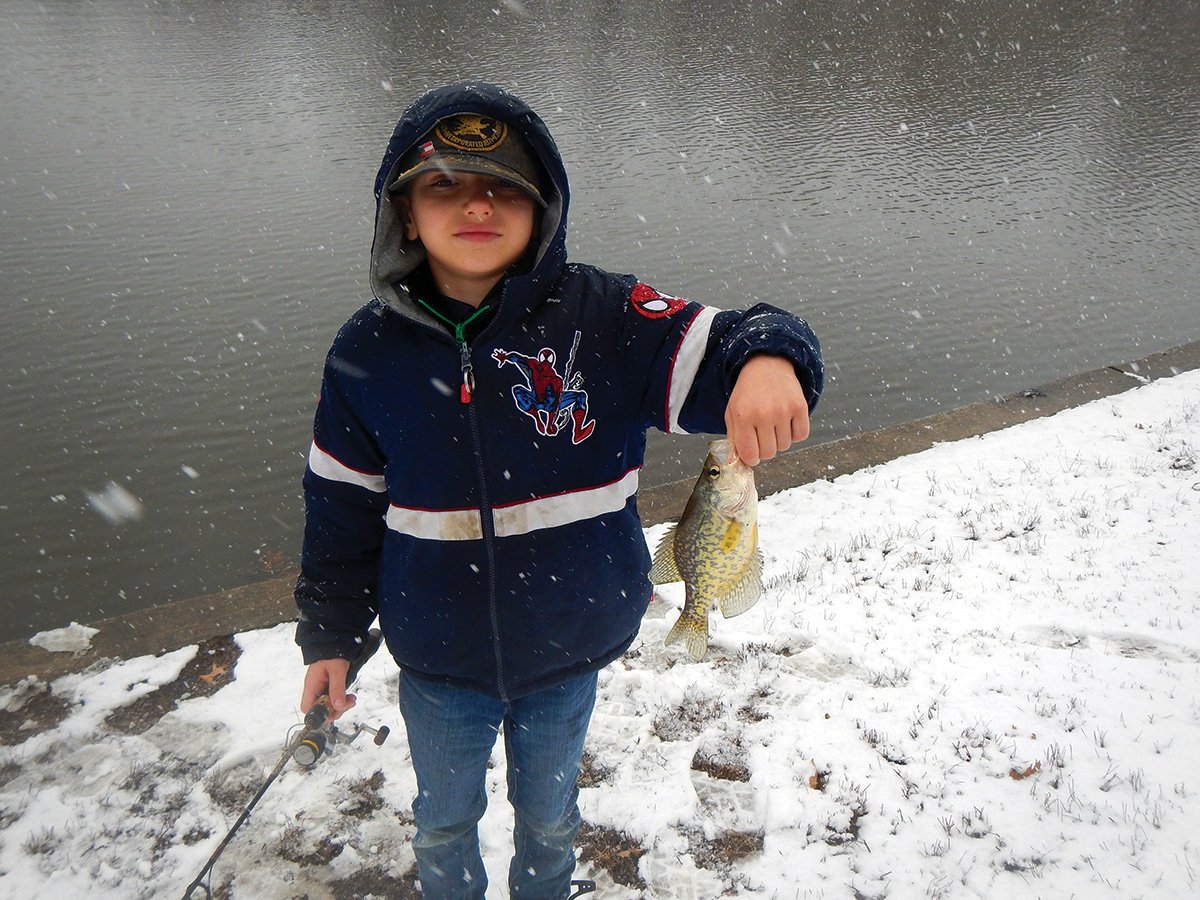
Jigging with hair jigs, tiny plastic baits and other small lures is the best way of taking the crappies that are holding in these areas. Remember a fish’s metabolism, even fish that prefer cold water, slows down. Since it takes them longer to digest their food, they are feeding on smaller forage. As such, keep your jig combinations small in the 1/32-, 1/64- or 1/80-ounce range. That said, fishing the most productive, tiniest of jigs requires use of ultra-light spinning tackle packed with 2- and 4-pound test, which makes for a better and more precise presentation.
Most times the crappies and other fish will be holding tight to the pilings or within a few feet. The colder the water gets the closer to the pilings they will hold. Pilings that are in direct sun light can also be a degree or three warmer tight to the piling. Your best bet often is to stand on the bridge or piling and lower your jig combinations right down along side of the pilings.
Crappies are often suspended in a certain layer of water at a certain depth. If there are perch or bluegills around they will most often be found under the crappies, usually right along the bottom. To determine the depth where crappie are holding lower your jigs down a couple of feet and bounce them around for a few minutes, then lower it a couple more feet. Once you find the proper depth you can lower your baits to the same depth over and over.
Many times crappies will be holding under the bridge; if you find this is the case, try flipping your jig under the bridge and allow it to fall slowly into the depths and retrieve it with a stop and go motion watching your line for the slightest tap.
Dam Spillways
One thing that happens when the weather really closes in, is that it really cuts down on the places you have to fish. One place you will find crappies the year round is in a dam spillway. Reasoning is that a dam spillway boasts moving water; while it may freeze around the edges, it will not completely freeze over, even in the coldest of weather. This often keeps the fish found there relatively active.
Likewise a dam spillway is the farthest place fish can migrate upstream in the fall, and crappies that move into them during the fall will hold there all winter and into the spring. They are also ideal places because they are located below dams and are most often well protected from the wind. This makes them an ideal place to fish when it’s cold in reasonable comfort.
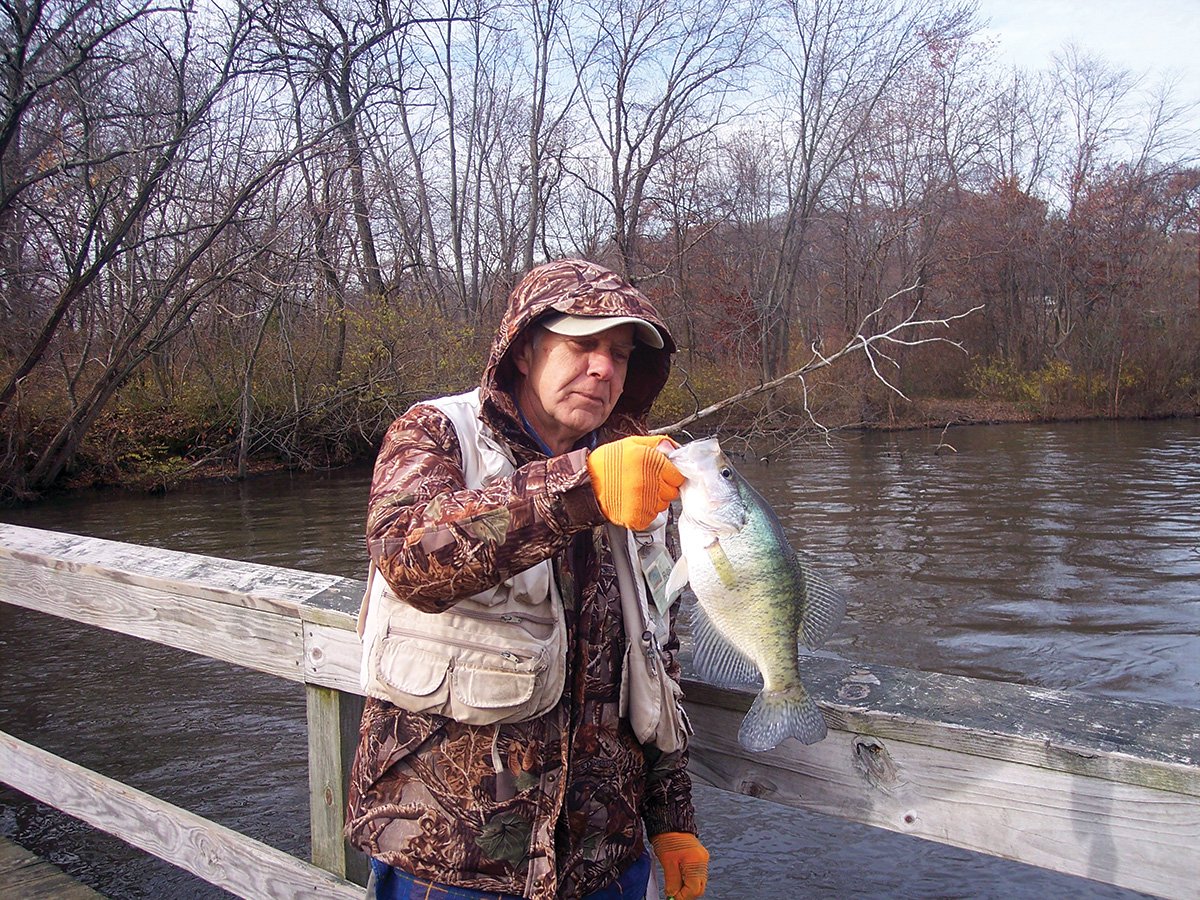
Even though the water in the spillway is moving, there is no question that it is still very cold, which makes the crappies sluggish; this means live bait will be a top choice. Small shiners, fatheads or killies make excellent bait to liveline or fish under bobbers for the crappies. Unlike fishing in the warm water when you want to set the hook as soon as he hits the bait, you will have to allow the crappies a few seconds to swallow the bait before setting the hook.
Another good choice, especially in the late winter in a spillway, is an in-line spinner such as a small (size 0, 1 or 2) CP swing, Mepps, or Roostertail. These are the places where you will want to cast your spinners and reel them slowly through the quiet water areas and allow their flashing blades to attract the fish.
Headwaters and tributary streams are other prime locations where water remains open in the winter, even when the main lake might be frozen. They are also prime areas for baitfish to hold in and the moving water also carries insects and other forage to the crappies. Likewise they are a place that warms up quickly if a few days of unseasonable warm weather presents itself. In the late winter they are places where early season spawners such as perch, shiners, suckers, etc. will move into spawn.
One of the most effective ways of taking the crappies in headwaters and tributary streams is with the use of jigs fished under small floats (peg floats, torpedo floats, ball floats, etc.) combined with tiny jigs ranging in size from 1/32- to 1/100-ounce fished with ultra-light tackle. Hair jigs are one of the most productive types of jigs for winter crappies, however dressing your jigs with plasticbaits can also be very effective. Some of the top, plastic baits are small 1-1/2-and 2-inch tubes, Fin-S shads, Bobby Garlands, Panfish Assassins and small Twister Tails.
When working your jigs under floats during the cold water season, slow and slower is the way to fish them. Simply cast into a likely looking spot and allow the water to settle down around them. Then twitch your rod tip slightly to make the float dance on top of the water, which in turn will give the jigs their action. Crappies will usually hit the jig hard causing the float to pop up on the surface, then slowly take the float under the water. A lot of times when the water is very cold their hits will be very light and you will have to set the hook at the first bump of the crappie.
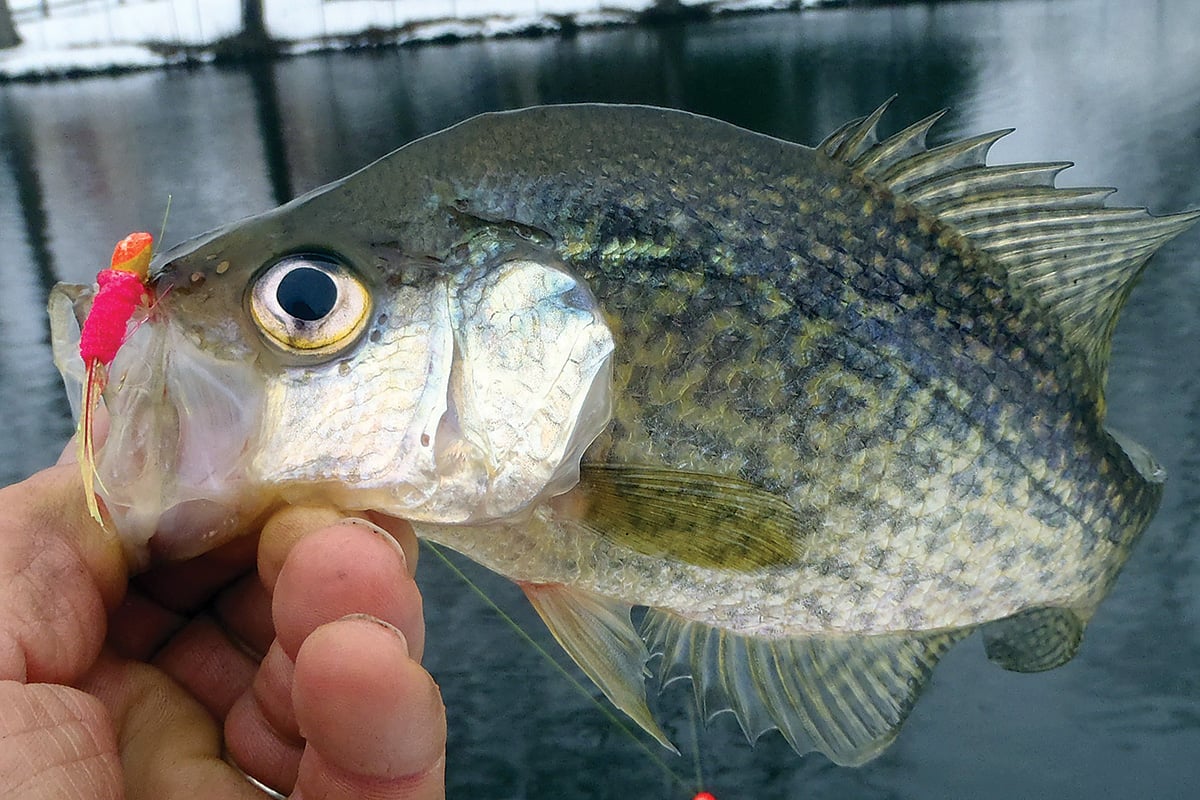
Hard Water Crappie
Of all the panfish that anglers seek below the frozen waters of a lake during the winter season, perhaps no other is more sought after than the crappie. Not only are they a fun fish to catch they also make an excellent table treat when taken from cold waters during the winter. Their schooling nature can give anglers some fast action when they are on the feed and their diverse diet gives the angler many choices in baits and lures when fishing the hardwater.
During the winter months the crappie school up a lot closer than during the warm water season and they will stay close to structure as long as forage is available to hold them. If the forage is depleted around a certain structure they will move off and look for another forage holding structure. Although crappie prefer moderate depths they have been known to move into deeper water (25 feet plus).
Among seasoned ice fishermen jigging is the top method used for crappie. Jigging rods can be just about any concoction a fisherman can come up with. Cut down fly rods, homemade jigging rods, commercially made jigging equipment and in a pinch your favorite ultra-light spinning outfit.
Crappies will often hit very light and many veteran anglers add a spring bobbin’ to their jigging rods. This is a piece of light wire with an eye attached to it that is mounted on the tip of the rod, which allows you to detect the slightest hit.
Jigging through the ice for crappie will require that you cut many holes. The best option is a power auger, especially if you are fishing on thick ice, however a razor sharp hand auger or ice chisel will also work.
Crappies are notorious for haunting brush piles, submerged trees, docks and bridge pilings. These areas are best located during the open water season and plotted on a lake chart for future use. Another area where crappie will gather is among submerged weed beds, which are especially productive when they are found in combination with other structures.
High on the list of those structures for crappie when ice fishing are drop-offs and points of land. The key to fishing them is to find something that is different located along or near them such as a brush pile, weed bed, rock pile or other object. Once you have located a promising area you should start by cutting several holes directly over it and then working your way out into deeper water and along the drop-off. If crappie are holding to the object you will make contact with them quickly.
If the drop-off that you are fishing has more than one object located along it, it’s best to cut holes over and around all of them and move from place to place fishing each hole for a few minutes. This a common practice if you are fishing a drop-off that has submerged standing trees such as those found in a manmade reservoir. Quite often there is something about one or two of the trees that will make them more productive than the others around them.
Dress warm and keep on fishing!

